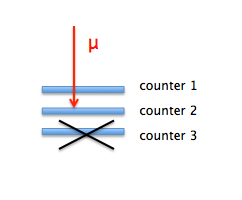|
|
||
|
A classic modern physics experiment is the measurement of the muon mean lifetime. Some short-lived cosmic ray muons that reach Earth's surface may stop in a counter,
wait around a while and then decay into an electron, a neutrino and an anti-neutrino. The muon will leave one signature in the detector, and the electron will leave another.
One can ask, "How long before the muon decays? What is its lifetime?" Consider the figure below.
 When a muon enters a counter, a signal is generated in that counter. If the muon travels through counter 1 and into counter 2, both of these counters should have a signal at approximately the same time. This is called a two-fold coincidence (signal seen in two counters within a certain small time window). If the muon has stopped within counter 2, however, it will "wait around" until it decays and generate a second signal in the same counter (2) upon decay. The time between the two signals in counter 2, tDECAY, can be calculated from the raw data file. Furthermore, if no signal occurs in counter 3 (the veto counter), this is a strong indication that a muon did indeed decay in counter 2. Although existing e-Lab tools do not include veto capability in software, the DAQ can be configured to require a veto counter in hardware. In other words, veto is a useful concept but not available in the e-Lab analysis tools at the moment. For more background, see how the detector works. |
||
